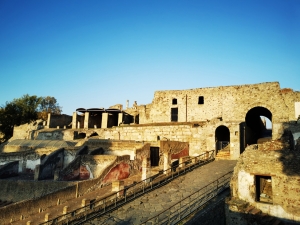
The perimeter of the city walls of Pompeii is 3220 m and has seven recognized gates; of an eighth – Capua Gate – it was assumed the existence based on a possible symmetry in the position of the gates. (1) Like any city in the ancient world, the walls of Pompeii were of particular importance because, in addition to performing a defensive function, they also marked the passage between the urbs (city) and the ager (countryside), between citizens and those who were not yet citizens (the indigenous rural population, for example) or those who were no longer (the deceased). The city walls were impassable because they were untouchable in the religious and legal sense of the term. The jurist Gaius, active between the reign of Hadrian and that of Marcus Aurelius (2nd century AD), used the term “res sanctae” (sacred property) to indicate the walls and their gates. (2) To justify and legitimately base the appropriation of a space which was completely removed from the domain of Nature, a divine origin sanctioned in its own settlement with its walls in order to directly involve the Gods in the fate of the city. (3) In Greek times in many cases – in Magna Graecia we know the cases of Locri and Agrigento – the sacred areas were located along the route of the city walls, both internally and externally, to constitute the best known cases of “ceinture sacrée” (sacred city walls), according to a lucky definition by François de Polignac. In practice, the whole city was physically placed under the protection of the Olympian Gods, through a widespread distribution of sacred areas along the perimeter of the city walls, above all at the gates. (4)
It is surprising how this description of “ceinture sacrée” can be perfectly found even in Pompeii. In fact, with the exception of the “Capitolium”, obviously located in the Forum, all the main sacred sanctuaries (Temple of Apollo, the Triangular Forum, Temple of Aesculapius or Jupiter Meilichios, the Temple of Venus) lie by two of the seven city gates, the so-called “Marina Gate” and “Stabian Gate”.
Furthermore, city gates marked a border that was often demarcated not only by physical defenses (towers, ditches, gates), but also by symbols that evoked a magical protection of urban space (sacred images, apotropaic symbols) (5). Interesting in this regard is what was found, for example, in the niche at the main archway of Porta Marina in Pompeii: a fictile statue of Minerva, guardian goddess of the city gates. (6)
For what concerns the first urban nucleus of Pompeii, until a few decades ago, it was thought that it was much more limited and its walls developed around the “Vicolo del Lupanare”, “Vicolo degli Augustali” and ” Vicolo dei Soprastanti ”, which is the closest territory to the current Forum. This theory was also reinforced by the presence, in the aforementioned area, by urban planning oriented in a different way from the rest of the city. It was then thought that, later, around the fifth century BC, the city had developed towards the East and North. In other words, it was believed that, after an initial urbanistic phase where Pompeii developed to just 9.3 hectares, it later developed to 63.5 hectares. (7)
To crown the aforementioned theory, in 1979 the German scholar Hans Eschebach published an authoritative monograph, which stated that in the 6th century BC, where today the “Stabian Baths” rise, the fortifications ran with a moat and a city gate. (8)
BIBLIOGRAPHY:
- Eugenio La Rocca, Mariette e Arnold de Vos, Guida archeologica di Pompei, Arnoldo Mondadori Editore, 1976, pp. 85
2. P. Gros, L’architettura romana dagli inizi dal III secolo a.C. alla fine dell’Alto Impero: i monumenti pubblici, Milano, Longanesi & C. 2001, pag 28
3. Giuseppe Gisotti, La Fondazione delle città, Carocci Editore, 2016, pp. 17-18
4. Gioacchino Francesco La Torre, Sicilia e Magna Grecia, Editori Laterza, 2011, pag.299
5. Giuseppe Gisotti, op. cit. pag. 18
6. Fabrizio Pesando, Maria Paola Guidobaldi, Pompei, Oplontis, Ercolano, Stabiae, Guide Archeologiche Laterza, Bari, 2018, pag. 31
7. Eugenio La Rocca, Mariette e Arnold de Vos, op. cit., pp .12-13
8. Monika Trümper, Curare se stessi, in Massimo Osanna e Carlo Rescigno, Pompei e i Greci, Electa, 2017, pag. 265
For further info about our guided tours of Pompeii and Herculaneum




